Click to Read: ● Catholicism Exposed (Exposing Lies of the Catholic Church)
● Mystery Babylon (The Illuminati / Masonic / Catholic Connection)
● THE ORIGINS OF PURGATORY (AND EGYPT, GREECE, ETC.)
● Pagan Origins of the Mediatrix and the Eucharist
● EXPOSING CATHOLICISM'S LIES: PRAYING TO SAINTS
● Catholic Items Originating from Paganism
● Origins of the Rosary and the Sacred Heart
● Fire Worship and Catholicism
● Wax Candles and Fire Worship (Catholic Worship Exposed)
● Mormonism Exposed (The LDS Church Exposed)
● "Jehovah's Witnesses" Exposed (Watchtower Society Exposed)
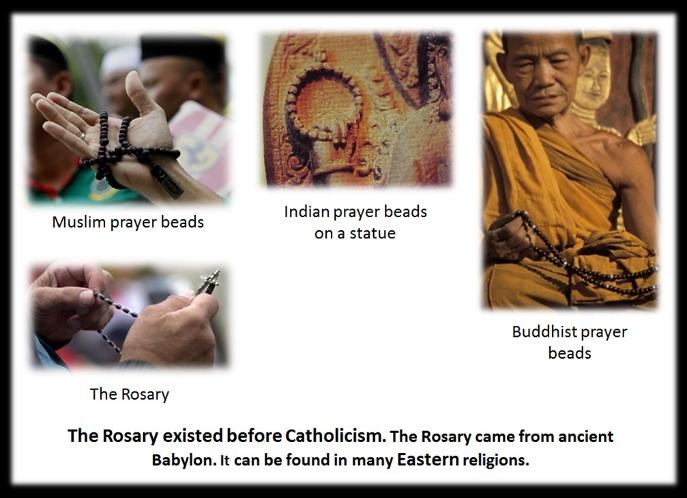
The Origin of the Rosary
The Rosary is a string of beads or a necklace which Catholics use to aid them in prayer. The Rosary has been in existence long before Catholicism and it can be found in many parts of the world from in ancient times.
Alexander Hislop, a historian, writes about it in The Two Babylons (p. 154) (bold / underline / color added):
Every one knows how thoroughly Romanist [or Catholic] is the use of the rosary; and how the devotees of Rome mechanically tell their prayers upon their beads. The rosary, however, is no invention of the Papacy. It is of the highest antiquity [from ancient times], and almost universally found among Pagan nations. The rosary was used as a sacred instrument among the ancient Mexicans.
[The Rosary was Used by Ancient Hindus (from India)]
It is commonly employed among the Brahmins of Hindustan [or northern India and Pakistan]; and in the Hindoo sacred books reference is made to it again and again. Thus, in an account of the death of Sati, the wife of Shiva, we find the rosary introduced: "On hearing of this event, Shiva fainted from grief; then, having recovered, he hastened to the banks of the river of heaven, where he beheld lying the body of his beloved Sati, arrayed in white garments, holding a rosary in her hand, and glowing with splendour, bright as burnished gold." In Thibet it has been used from time immemorial, and among all the millions in the East that adhere to the Buddhist faith. The following, from Sir John F. Davis, will show how it is employed in China: "From the Tartar religion of the Lamas, the rosary of 108 beads has become a part of the ceremonial dress attached to the nine grades of official rank. It consists of a necklace of stones and coral, nearly as large as a pigeon's egg, descending to the waist, and distinguished by various beads, according to the quality of the wearer. There is a small rosary of eighteen beads, of inferior size, with which the bonzes count their prayers and ejaculations exactly as in the Romish ritual. The laity in China sometimes wear this at the wrist, perfumed with musk, and give it the name of Heang-choo, or fragrant beads."
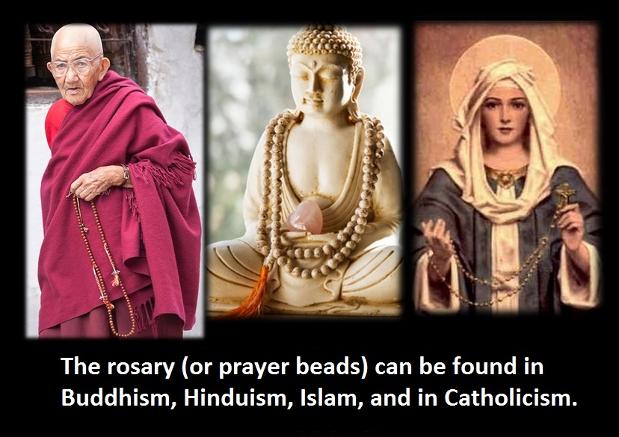
(The rosary (or prayer beads) can be found in Buddhism, Hinduism, Islam, and in Catholicism.)
Hislop (pg. 154):[The Rosary was Used by Ancient Greeks and Romans]
In Asiatic Greece the rosary was commonly used, as may be seen from the image of the Ephesian Diana. In Pagan Rome the same appears to have been the case. The necklaces which the Roman ladies wore were not merely ornamental bands about the neck, but hung down the breast, just as the modern rosaries do; and the name by which they were called indicates the use to which they were applied. "Monile," the ordinary word for a necklace, can have no other meaning than that of a "Remembrancer." Now, whatever might be the pretence, in the first instance, for the introduction of such "Rosaries" or "Remembrancers," the very idea of such a thing is thoroughly Pagan. * It supposes that a certain number of prayers must be regularly gone over; it overlooks the grand demand which God makes for the heart, and leads those who use them to believe that form and routine are everything, and that "they must be heard for their much speaking."
* "Rosary" itself seems to be from the Chaldee "Ro," "thought," and "Shareh," "director."
Seeing that the Rosary was used by ancient cultures prior to Catholicism, every Catholic should consider why her or she uses the Rosary to pray. The Bible never teaches that prayers must be done according to a ritual. Hislop has shown that the Rosary is of a pagan origin and it is not scriptural. Christians and pagans should not mix.
2 Corinthians 6:14 says, "Be ye not unequally yoked together with unbelievers: for what fellowship hath righteousness with unrighteousness? and what communion hath light with darkness?"
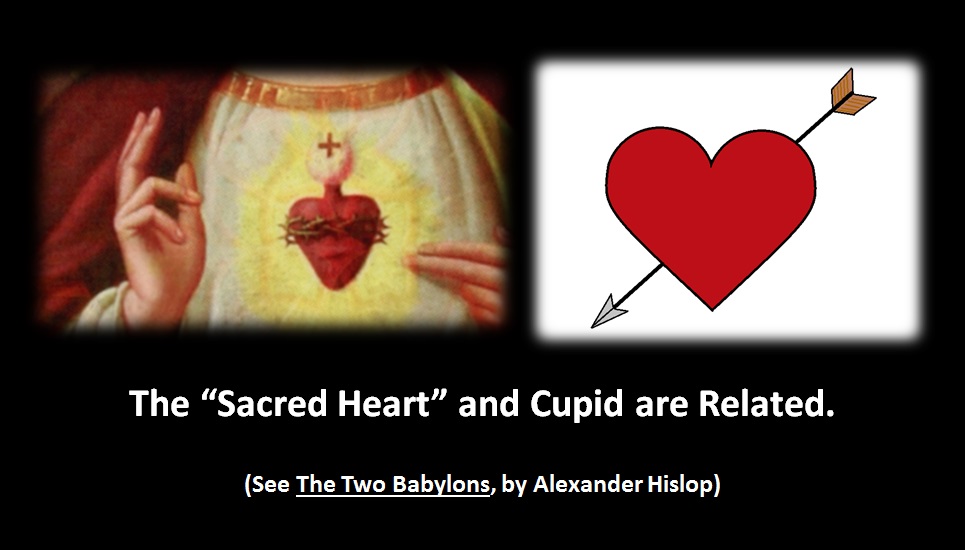
The Origin of the "Sacred Heart"
Catholics around the world hold the "Sacred Heart" of "Christ" or "Mary" in high esteem. Many Catholic organizations are named after it. Some people pray to it.
Alexander Hislop will now tell us about the origin of the Sacred Heart (The Two Babylons, p. 155-156) (bold / underline / color added):
In the Church of Rome a new kind of devotion has of late been largely introduced, in which the beads play an important part, [....] I refer to the "Rosary of the Sacred Heart." It is not very long since the worship of the "Sacred Heart" was first introduced; and now, everywhere it is the favourite worship. It was so in ancient Babylon, as is evident from the Babylonian system as it appeared in Egypt. There also a "Sacred Heart" was venerated. The "Heart" was one of the sacred symbols of Osiris when he was born again, and appeared as Harpocrates [or Horus], or the infant divinity, * borne in the arms of his mother Isis.
* The name Harpocrates, as shown by Bunsen, signifies "Horus, the child."
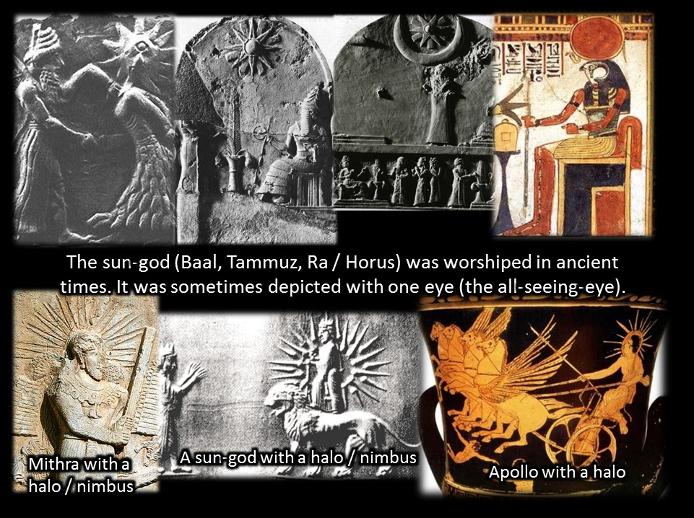
[The sun-god (Baal, Tammuz, Ra / Horus) was worshiped in ancient times. It was sometimes depicted with one eye (the all-seeing-eye).]
Therefore, [...] this infant divinity was frequently represented with a heart, or the heart-shaped fruit of the Persea, in one of his hands. The following extract, from John Bell's criticism on the antiques in the Picture Gallery of Florence, will show that the boyish divinity had been represented elsewhere also in ancient times in the same manner. Speaking of a statue of Cupid, he says it is "a fair, full, fleshy, round boy, in fine and sportive action, tossing back a heart." Thus the boy-god came to be regarded as the "god of the heart," in other words, as Cupid, or the god of love. To identify this infant divinity, with his father "the mighty hunter," [Nimrod] he was equipped with "bow and arrows"; and in the hands of the poets,[...] this sportive boy-god was celebrated as taking aim with his gold-tipped shafts at the hearts of mankind.
His real character, however, [...] as we have seen reason already to conclude, was [...] of a very different kind. He was the woman's seed [the son of Semiramis, who claimed to be a goddess]. Venus and her son Cupid, then, were none other than the Madonna and the child. Looking at the subject in this light, the real force and meaning of the language will appear, which Virgil puts into the mouth of Venus, when addressing the youthful Cupid:--
"My son, my strength, whose mighty power alone
Controls the thunderer on his awful throne,
To thee thy much afflicted mother flies,
And on thy succour and thy faith relies."
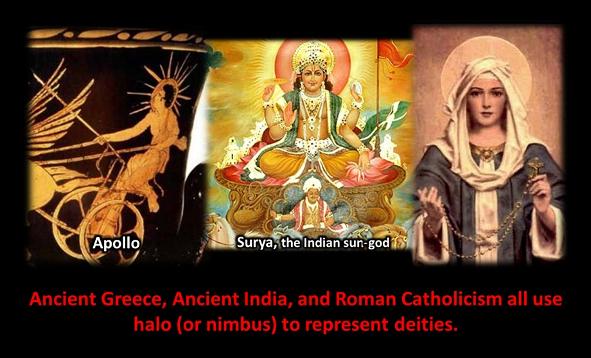
(Ancient Greece, Ancient India, and Roman Catholicism all use the hall (or nimbus or sun-disk) to represent deities. The halo is seen in many Catholic paintings and statues of "saints". This is not Christian but pagan.)
This heart-shaped bulla was given to a Roman child for a "god" (most likely cupid, who is based on Tammuz) to protect the child.From what we have seen already as to the power and glory of the Goddess Mother being entirely built on the divine character attributed to her Son [...] the Son is called "THE STRENGTH" of his Mother. As the boy-god, whose symbol was the heart, was recognised as the god of childhood, this very satisfactorily accounts for one of the peculiar customs of the Romans. Kennett tells us, in his Antiquities, that the Roman youths, in their tender years, used to wear a golden ornament suspended from their necks, called bulla, which was hollow, and heart-shaped. Barker, in his work on Cilicia, while admitting that the Roman bulla was heart-shaped, further states, that "it was usual at the birth of a child to name it after some divine personage, who was supposed to receive it under his care"; but that the "name was not retained beyond infancy, when the bulla was given up."
Hislop tells us that the "sacred heart" was worshiped in ancient India and that it comes from the ancient Babylon deity, Bel (ibid, p. 155):
The veneration [worship] of the "sacred heart" [reached] [...] India, for there Vishnu, the Mediatorial god, in one of his forms, [...] [was wounded] in his foot, [...] he died, [...], [Vishnu] is represented as wearing a heart suspended on his breast.
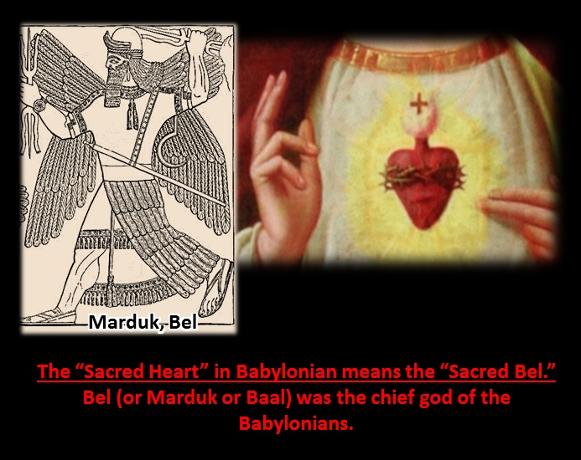
[The "Sacred Heart" means the "Sacred Bel." The Chaldean word for "heart" was "bel" and their chief god was also called Bel. Bel (or Marduk or Baal) was the chief god of the Babylonians. He was connected to sun-worship. Fire was used to worship Baal--a Canaanite version of Tammuz, the son of Nimrod. Sun worship happened when man rebelled against the One true God and built the tower of Babel. Romans 1:25 says, "Who changed the truth of God into a lie, and worshiped and served the creature more than the Creator, who is blessed for ever. Amen."]
[The "Sacred Heart" means the "Sacred Bel", Bell: Nimrod.]
[...] How came it that the "Heart" became the recognised symbol of the Child of the great Mother? The answer is, "The Heart" in Chaldee is "BEL"; [...] almost all the most important elements of the Chaldean system were introduced under a veil [...] [and] shrouded from the gaze of the uninitiated [or common people], [....]
Now, the worship of the "Sacred Heart" was just, under a symbol, the worship of the "Sacred Bel," that mighty one of Babylon [Nimrod], who had died a martyr for idolatry; for Harpocrates, or Horus, the infant god, was regarded as Bel, born again.
That this was in very deed the case, the following extract from Taylor, in one of his notes to his translation of the Orphic Hymns, will show. "While Bacchus," says he, was "beholding himself" with admiration "in a mirror, he was miserably torn to pieces by the Titans, [...] but while they were tasting his flesh [...], Jupiter, [...], committed his members to Apollo, the brother of Bacchus, [....] And this being performed, Dionysius [i.e., Bacchus], (whose HEART, during his laceration, was snatched away by Minerva and preserved) by a new REGENERATION, again emerged, [....]"
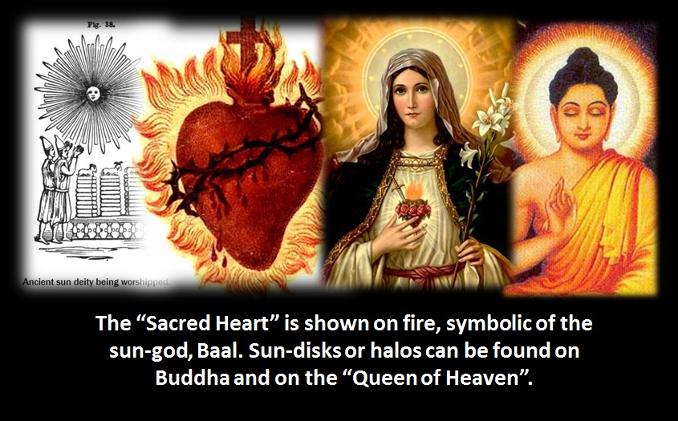
(The "Sacred Heart" is shown on fire, symbolic of the sun-god, Baal (Tammuz, Apollo, Surya, etc.). Sun-disks or halos (nimbus) can be found on Buddha, and Surya (Indian sun-god), and Apollo, and on the "Queen of Heaven".)
[The "Sacred Heart" is the heart of the sun-god, Bel (Marduk, Baal, Tammuz, or Nimrod).]
This surely shows, [...] [the] sacredness of the heart of Bacchus; and that the regeneration of his heart has the very meaning I have attached to it--viz., the new birth or new incarnation of Nimrod or Bel. When Bel [or Baal], however was born again as a child, he was, as we have seen, represented as an incarnation of the sun. Therefore, to indicate his connection with the fiery and burning sun, the "sacred heart" was frequently represented as a "heart of flame." So the "Sacred Heart" of Rome [Catholicism] is actually worshipped as a flaming heart, as may be seen on the rosaries devoted to that worship.
_________________________________________
Matthew 4:1010 Then saith Jesus unto him, Get thee hence, Satan: for it is written, Thou shalt worship the Lord thy God, and him only shalt thou serve.
Jesus Christ is the Word. See John 1:1. Jesus Christ (part of the Holy Trinity) is our only God, our only Mediator,1 John 5:77 For there are three that bear record in heaven, the Father, the Word, and the Holy Ghost: and these three are one.
1 Timothy 2:5“For there is one God, and one mediator between God and men, the man Christ Jesus;”
Ephesians 2:8-9
8 For by grace are ye saved through faith; and that not of yourselves: it is the gift of God:
9 Not of works, lest any man should boast.
John 17:3 says: "And this is life eternal, that they might know thee the only true God, and Jesus Christ, whom thou hast sent."